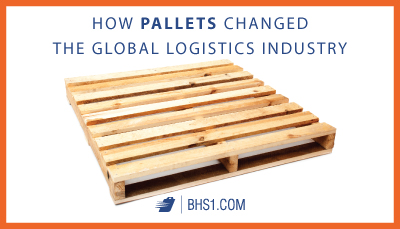We use cookies to make your experience better. To comply with the new e-Privacy directive, we need to ask for your consent to set the cookies. Learn more.
How Pallets Changed the Global Logistics Industry
In a very real way, the simple wooden pallet was the spark that ignited the entire global economy as we know it. Before the advent of pallets during World War II, shipments consisted of awkward piles of boxes, barrels, canisters, and loose product. Warehouse staff would pack trucks any way they could. The process was inefficient in terms of both time and space.
Then came the pallet, which co-evolved with the gas-powered lift truck. With forklifts and pallets, material handling efficiency entered the modern era. Wooden pallets are simple structures, but they accomplish incredible things — things that allow supply chains to function smoothly in this age of global logistics and long-distance retail. Here are four key innovations that pallets make possible: 
-
They combine dissimilar shipments into standardized units.
Managers of third-party logistics providers often have to mix different products within a single shipping container. Thanks to pallets, they have a common unit for dissimilar items. That simplifies everything, from planning shipments to actually handling the loads.
As online shopping continues to gain market share, the importance of "mixed-product SKUs," or pallets loaded with multiple types of items, will only grow. Mixed-product SKUs allow manufacturers to ship smaller orders without adding to costs, ultimately opening up new audiences for their products.
-
The standardization of shipments allowed material handling equipment and warehouse shelving to become more standardized.
The common shape and method of access that pallets bring shipments has rippled across the entire material handling industry. Pallets first gained popularity with the invention of the lift truck; the two are made for each other. As of 2015, material handling staff used about 6 million lift trucks globally.
Even warehouse shelving has been redesigned to work better with pallets. Today, most warehouses use some form of pallet racking, whether that's single deep, flow-through, or mobile sliding racks.
-
They saved employees from manual labor, reducing musculoskeletal disorders.
Forklifts and other pallet handling equipment prevent staff from moving loads manually, removing the risk of developing an ergonomic injury. The only ergonomic risks associated with pallets occur when building or unpacking them.
Material handling operations can even eliminate this risk by providing staff with a Pallet Carousel & Skid Positioner. This self-leveling lift table keeps pallet loads at a uniform position close to the worker's body. A rotating turntable provides staff with 360-degree access to pallets without risky bending, reaching, or stretching.
-
They give companies opportunities to reduce shipping costs.
The more products you can fit onto a single pallet, the cheaper overall shipping costs will be. That's why companies like Ikea sometimes design their products specifically to fit onto the pallet's footprint.
Ikea redesigned their "Bang" mug three times to fit better into pallet loads. By the third iteration, the company had reduced shipping costs for the mug by 60 percent.
Pallets Continue to Drive Global Supply Chains
Pallets have evolved a little bit since their 1940s debut. They're available in plastic, or with thinner profiles to save space in trucks. Pooled pallets are fitted with RFID chips to make retrieval easier.
Essentially, though, they're the same trusty tools. They carry our goods around the world faster and more safely than anything we've discovered yet. Odds are they'll continue to fuel supply chains all over the world for some time to come.
References:
"Industrial History: Pallets." TheMHEDAJournal. MHEDA Journal, n.d. Web. 10 July 2017.
Vanderbilt, Tom. "The Single Most Important Object in the Global Economy." Slate. The Slate Group, 14 Aug. 2012. Web. 10 July 2017.
